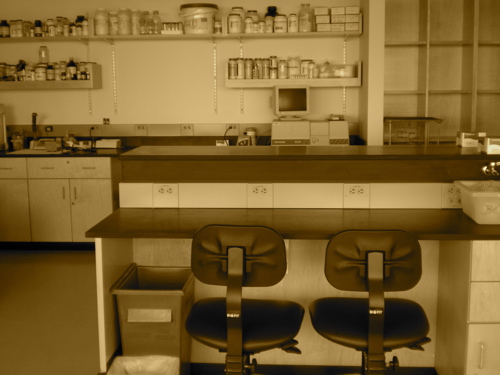20.109(S10):Purify RNA and run affinity column (Day4)
Contents
Introduction
Today will be a busy day! Last time you prepared the 6-5 and 8-12 aptamers by an in vitro transcription reaction. Now you must purify the RNA before enriching the heme-binding aptamer on an affinity column.
To isolate RNA and change the buffer we are in, we will again do a column purification. However, this time the matrix will be a polyacrylamide gel rather than a silica resin. This size exclusion matrix retains nucleic acids longer than 20 bases. After purification, you will quantify your RNA by spectrophotometry. The absorbence at 260 nm indicates the RNA concentration, and the absorbance at 280 nm gives some indication of purity. As a final preparation, the appropriate amount of RNA must be denatured at 70 °C and re-natured at room temperature in order to ensure that it has the right secondary structure.
By now you should have signed up for your experimental conditions on today's Talk page. You and your partner will use the same ratio of aptamers, but a different number of column washes. (Vice versa?) The affinity column you will use consists of agarose beads with bound heme. Thus, when you add your aptamers to the column, 8-12 should bind but 6-5 should not. Of course, some 6-5 will non-specifically bind to the column. To wash it away you will add aliquots of selection buffer to the column and let the 6-5 wash away. If you wash too vigorously, you may lose some 8-12 as well. Part of today's experiment is to hone in on the ideal wash conditions. Finally, to collect the 8-12 that is bound to the column, you will add a concentrated heme solution. The free heme will compete with the bound heme for 8-12 binding, and 8-12 should be eluted after a brief incubation step. One additional complication is that nucleic acids bind non-specifically to agarose. The, we will use tRNA in our buffer to compete with the aptamers for these non-specific sites.
Once you have collected your samples, you will begin the process of concentrating the collected RNA. A common way to do this is by salt and ethanol precipitation. The ethanol lowers charge-charge screening, allowing the positive ion of the salt to ionically bind and precipitate out the negatively charged nucleic acids.
Protocols
Part 1: Prepare spin purification columns and purify RNA
- Take your thawed IVTs from last time, and add 1/10 volume of DNase to each reaction. Place on the 37 °C heat block for 30 min, and meanwhile prepare the columns.
- During spins and incubations, you may also be able to begin Part 2 below.
- Take one Micro Bio-Spin Columns and one 2 mL microfuge tube per reaction, and for each:
- Rapidly flip the column back and forth to resuspend the gel, then flick or tap it to rid air bubbles.
- Snap off the plastic tab at the bottom of the column (a little buffer may flow out), and place the column in the 2 mL microfuge tube. Let the excess buffer drain off.
- When the buffer stop flowing, centrifuge the tube for 2 min at 1000 g. (Is g the same as rcf or rpm? Ask if you’re not sure!)
- Add 500 μL of Selection Buffer to the top of the column. Let it drain by gravity for a couple of minutes, then spin for 1 min at 1000g.
- Repeat step 6 three more times. Meanwhile, label 1.5 mL eppendorf tubes for collection (on the side and with a label on the cap), and cut off their caps.
- Transfer each column to a 1.5 mL tube – both column and tube should be labeled, to be on the safe side – then add 75 μL of your IVT reaction gently to the center of the top surface of the gel.
- Centrifuge for 4 min, at 1000 g. Carefully replace the cap on each sample, and store on ice for now.
Part 2: Quantify RNA recovery
- For each RNA sample, you will add 5 μL of RNA to 695 μL of water. This ought to give you a measurement that's in a good readability range. You can prepare labeled eppendorf tubes containing the appropriate amount of water in advance.
- To get the most accurate measurement, you should also prepare a blanking solution that contains everything except the RNA. Per sample, that means 695 μL of water and 5 μL of selection buffer.
- As your RNA samples are ready, first measure the volume recovered to within a couple of mu;L (usually it is 85-90). Only then take 5 μL and to a water-filled eppendorf.
- Add 695 μL of blanking solution to a cuvette, and hit Blank on the spectrophotometer. Then dump the blanking solution, and add 695 μL of your RNA solution instead. Record the 260 nm and 280 nm absorbance values in your notebook. You can simply touch your finger on the screen for coarse wavelength selection, then touch the arrows for fine selection.
- Repeat for each sample.
Part 3: Prepare RNA for selection
Part 4: Column selection
Part 5: Begin RNA precipitation
- Measure the approximate volume (to within a few μL) of solution recovered.
- Add 1/10 volume of ammonium acetate, 1/200 glycogen, and 2.5 100% ethanol, in that order.
- For example, for a 200 μL solution, you would add 20 μL of the ammonium acetate.
- Give the teaching faculty your samples to be put away at -20 °C until next time.
